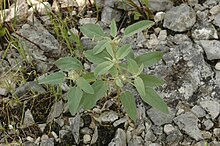
Croton capitatus

| Hogwort | |
|---|---|

| |
| Scientific classification | |
| Kingdom: | Plantae |
| Clade: | Tracheophytes |
| Clade: | Angiosperms |
| Clade: | Eudicots |
| Clade: | Rosids |
| Order: | Malpighiales |
| Family: | Euphorbiaceae |
| Genus: | Croton |
| Species: | C. capitatus
|
| Binomial name | |
| Croton capitatus | |
Croton capitatus, known as the hogwort,[1] woolly croton, or goatweed,[2] is an annual plant with erect, branched stems, densely covered with light brown, wooly hairs that give it a whitish appearance. It grows in dry, open areas, especially sandy and rocky soils.[2] It is distributed across the eastern United States.[1] Hogwort is a host plant for the goatweed leafwing butterfly (Anaea andria).[3]

In fiction
British author J. K. Rowling did not deliberately name the Hogwarts School of Witchcraft and Wizardry from her Harry Potter series of books after the hogwort. It was only after the books were published, when a friend reminded her of seeing the plant in the Kew Gardens many years beforehand, that Rowling speculated that the name had remained in her subconscious ever since.[4]

See also
References
- ^ a b c "NatureServe Explorer 2.0". explorer.natureserve.org.
- ^ a b "Hogwort (Woolly Croton)". Missouri Department of Conservation.
- ^ "Lady Bird Johnson Wildflower Center - The University of Texas at Austin". www.wildflower.org.
- ^ "Visitor's Guide to Hogwarts". The Harry Potter Lexicon. Retrieved 20 October 2007
External links


See what we do next...
OR
By submitting your email or phone number, you're giving mschf permission to send you email and/or recurring marketing texts. Data rates may apply. Text stop to cancel, help for help.
Success: You're subscribed now !

